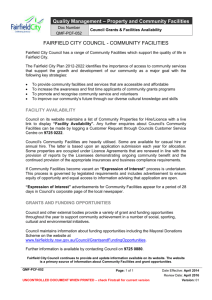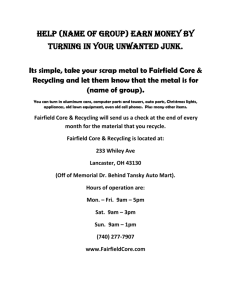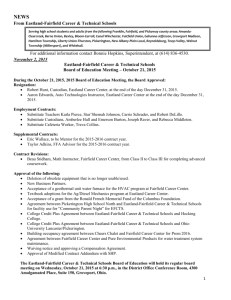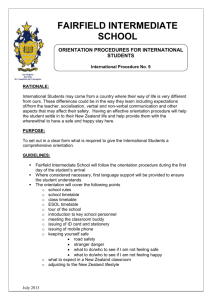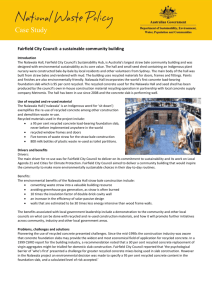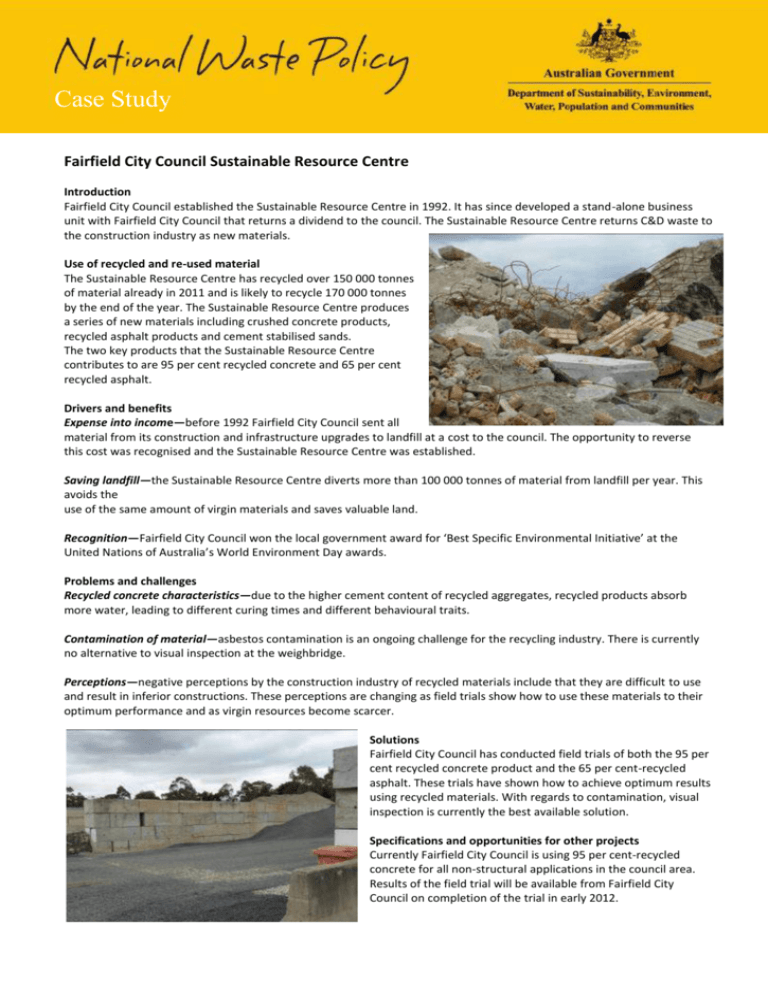
Case Study
Fairfield City Council Sustainable Resource Centre
Introduction
Fairfield City Council established the Sustainable Resource Centre in 1992. It has since developed a stand-alone business
unit with Fairfield City Council that returns a dividend to the council. The Sustainable Resource Centre returns C&D waste to
the construction industry as new materials.
Use of recycled and re-used material
The Sustainable Resource Centre has recycled over 150 000 tonnes
of material already in 2011 and is likely to recycle 170 000 tonnes
by the end of the year. The Sustainable Resource Centre produces
a series of new materials including crushed concrete products,
recycled asphalt products and cement stabilised sands.
The two key products that the Sustainable Resource Centre
contributes to are 95 per cent recycled concrete and 65 per cent
recycled asphalt.
Drivers and benefits
Expense into income—before 1992 Fairfield City Council sent all
material from its construction and infrastructure upgrades to landfill at a cost to the council. The opportunity to reverse
this cost was recognised and the Sustainable Resource Centre was established.
Saving landfill—the Sustainable Resource Centre diverts more than 100 000 tonnes of material from landfill per year. This
avoids the
use of the same amount of virgin materials and saves valuable land.
Recognition—Fairfield City Council won the local government award for ‘Best Specific Environmental Initiative’ at the
United Nations of Australia’s World Environment Day awards.
Problems and challenges
Recycled concrete characteristics—due to the higher cement content of recycled aggregates, recycled products absorb
more water, leading to different curing times and different behavioural traits.
Contamination of material—asbestos contamination is an ongoing challenge for the recycling industry. There is currently
no alternative to visual inspection at the weighbridge.
Perceptions—negative perceptions by the construction industry of recycled materials include that they are difficult to use
and result in inferior constructions. These perceptions are changing as field trials show how to use these materials to their
optimum performance and as virgin resources become scarcer.
Solutions
Fairfield City Council has conducted field trials of both the 95 per
cent recycled concrete product and the 65 per cent-recycled
asphalt. These trials have shown how to achieve optimum results
using recycled materials. With regards to contamination, visual
inspection is currently the best available solution.
Specifications and opportunities for other projects
Currently Fairfield City Council is using 95 per cent-recycled
concrete for all non-structural applications in the council area.
Results of the field trial will be available from Fairfield City
Council on completion of the trial in early 2012.
The 65 per cent recycled asphalt is being used across 30 locations
in the Fairfield City Council area.
Contacts and links
Fairfield City Council Sustainable Resource Centre
www.fairfieldcity.nsw.gov.au/default.asp?iSubCatID=288&iNavCa
tID=67
Consultation
Ross Smith, Manager Environment and Waste
Operations, Fairfield City Council
Daniel Begnell, Safety Quality & Environment
Coordinator, Fairfield City Council
Kerrie Whitehead, Operations Manager, Civil and Open
Space, Sustainable Resource Centre
Photos
Tom Davies, Edge Environment
© Commonwealth of Australia 2011
This work is copyright. You may download, display, print and reproduce this
material in unaltered form only (retaining this notice) for your personal, noncommercial use or use within your organisation. Apart from any use as permitted
under the Copyright Act 1968, all other rights are reserved. Requests and enquiries
concerning reproduction and rights should be addressed to Department of
Sustainability, Environment, Water, Populations and Communities, Public Affairs,
GPO Box 787 Canberra ACT 2601 or email public.affairs@environment.gov.au
The views and opinions expressed in this publication are those of the authors and
do not necessarily reflect those of the Australian Government or the Minister for
Sustainability, Environment, Water, Population and Communities.
While reasonable efforts have been made to ensure that the contents of this
publication are factually correct, the Commonwealth does not accept responsibility
for the accuracy or completeness of the contents, and shall not be liable for any loss
or damage that may be occasioned directly or indirectly through the use of, or
reliance on, the contents of this publication.

